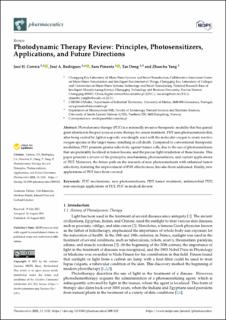Photodynamic therapy review: Principles, photosensitizers, applications, and future directions
Peer reviewed, Journal article
Published version
Permanent lenke
https://hdl.handle.net/11250/2994829Utgivelsesdato
2021Metadata
Vis full innførselSamlinger
- Institutt for mikrosystemer [546]
- Publikasjoner fra CRIStin [3623]
Originalversjon
Correia, J. H., Rodrigues, J. A., Pimenta, S., Dong, T. & Yang, Z. (2021). Photodynamic Therapy Review: Principles, Photosensitizers, Applications, and Future Directions. Pharmaceutics, 13(9), Artikkel 1332. https://doi.org/10.3390/pharmaceutics13091332Sammendrag
Photodynamic therapy (PDT) is a minimally invasive therapeutic modality that has gained great attention in the past years as a new therapy for cancer treatment. PDT uses photosensitizers that, after being excited by light at a specific wavelength, react with the molecular oxygen to create reactive oxygen species in the target tissue, resulting in cell death. Compared to conventional therapeutic modalities, PDT presents greater selectivity against tumor cells, due to the use of photosensitizers that are preferably localized in tumor lesions, and the precise light irradiation of these lesions. This paper presents a review of the principles, mechanisms, photosensitizers, and current applications of PDT. Moreover, the future path on the research of new photosensitizers with enhanced tumor selectivity, featuring the improvement of PDT effectiveness, has also been addressed. Finally, new applications of PDT have been covered.

